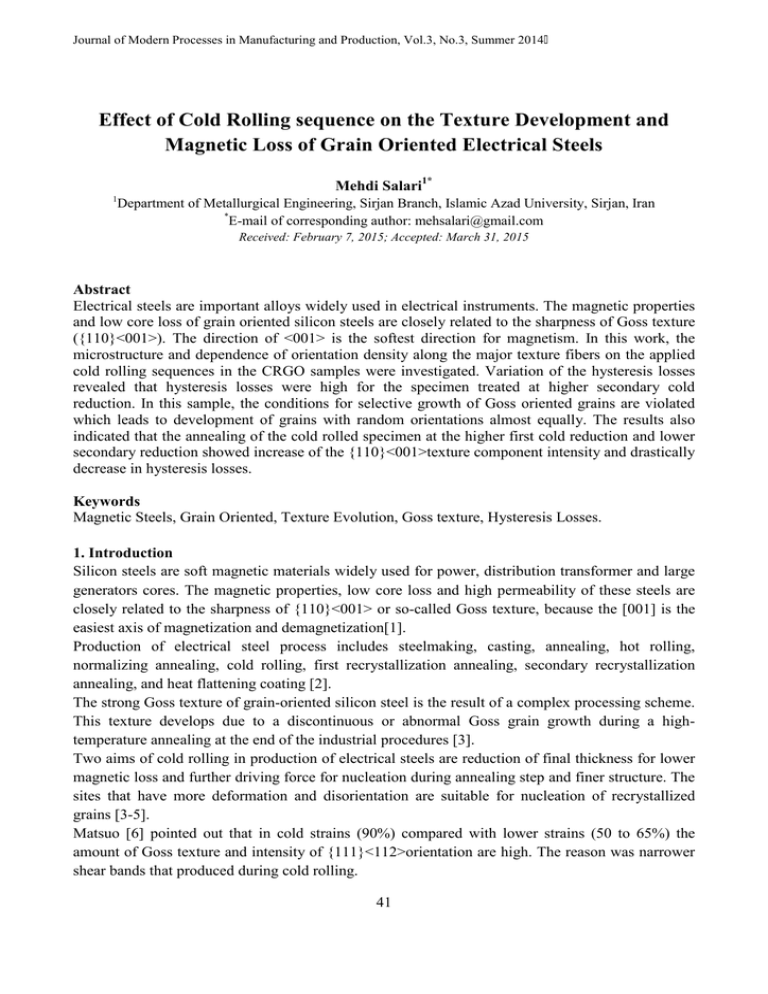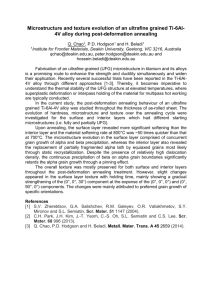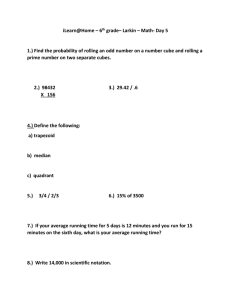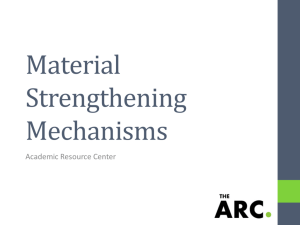- Journal of Modern Processes in Manufacturing and
advertisement

Journal of Modern Processes in Manufacturing and Production, Vol.3, No.3, Summer 2014
Effect of Cold Rolling sequence on the Texture Development and
Magnetic Loss of Grain Oriented Electrical Steels
Mehdi Salari1*
1
Department of Metallurgical Engineering, Sirjan Branch, Islamic Azad University, Sirjan, Iran
*
E-mail of corresponding author: mehsalari@gmail.com
Received: February 7, 2015; Accepted: March 31, 2015
Abstract
Electrical steels are important alloys widely used in electrical instruments. The magnetic properties
and low core loss of grain oriented silicon steels are closely related to the sharpness of Goss texture
({110}<001>). The direction of <001> is the softest direction for magnetism. In this work, the
microstructure and dependence of orientation density along the major texture fibers on the applied
cold rolling sequences in the CRGO samples were investigated. Variation of the hysteresis losses
revealed that hysteresis losses were high for the specimen treated at higher secondary cold
reduction. In this sample, the conditions for selective growth of Goss oriented grains are violated
which leads to development of grains with random orientations almost equally. The results also
indicated that the annealing of the cold rolled specimen at the higher first cold reduction and lower
secondary reduction showed increase of the {110}<001>texture component intensity and drastically
decrease in hysteresis losses.
Keywords
Magnetic Steels, Grain Oriented, Texture Evolution, Goss texture, Hysteresis Losses.
1. Introduction
Silicon steels are soft magnetic materials widely used for power, distribution transformer and large
generators cores. The magnetic properties, low core loss and high permeability of these steels are
closely related to the sharpness of {110}<001> or so-called Goss texture, because the [001] is the
easiest axis of magnetization and demagnetization[1].
Production of electrical steel process includes steelmaking, casting, annealing, hot rolling,
normalizing annealing, cold rolling, first recrystallization annealing, secondary recrystallization
annealing, and heat flattening coating [2].
The strong Goss texture of grain-oriented silicon steel is the result of a complex processing scheme.
This texture develops due to a discontinuous or abnormal Goss grain growth during a hightemperature annealing at the end of the industrial procedures [3].
Two aims of cold rolling in production of electrical steels are reduction of final thickness for lower
magnetic loss and further driving force for nucleation during annealing step and finer structure. The
sites that have more deformation and disorientation are suitable for nucleation of recrystallized
grains [3-5].
Matsuo [6] pointed out that in cold strains (90%) compared with lower strains (50 to 65%) the
amount of Goss texture and intensity of {111}<112>orientation are high. The reason was narrower
shear bands that produced during cold rolling.
41
Effect of Cold Rolling sequence on the Texture Development and Magnetic Loss of Grain Oriented… pp. 41-51
Harase et al. [7] concluded that with increasing strain, the number of suitable sites for nucleation
increases and by reduction of the space required for grain growth, recrystallization grain diameter
decreases. They emphasized that the rapid growth of the Goss grains in the secondary
recrystallization occurs when grain size of the primary recrystallization be small. Thus, cold rolling
has a great impact on the success or lack there of in the production of the Goss texture.
Many researchers [8-11] have stressed that the shear bands are the most important sites for
nucleation of the Goss area during recrystallization. Hutchinson [9] clarified the most important
factors, as the formation of shear bands, the temperature of the rolls, the friction and lubrication, the
stress and strain situation, local in homogeneity in grain size, size of precipitates and fault in one
area of the sample.
Heo[12] investigated the lubricating effect on cold-rolled magnetic steels and concluded that in the
final texture of the un-lubricated sample, the main orientation was{110}<001>, and in the sample
cold rolled with lubricants, the components of{554 }<225>, {100}<011>and{110}<001> had
greater presence. He also investigated the cold rolling and heating rate effects on magnetic
properties and texture of electrical steels and concluded that in the samples cold rolled without
lubricant, the Goss texture was strong, but in the samples cold rolled with lubricant, the Goss
texture was weak and dependent on the heating rate in the annealing step.
After researching the effect of cold rolling on the growth of the grains with Goss orientation in
silicon steels, Park [13,14] emphasized that with increasing the severity of cold rolling, more
distribution of inhibitor precipitates(such as MnSandAlN) is required for control of rapid migration
of the grain boundaries in secondary recrystallization.
Kim [15] showed that if cold and hot rolling direction is the same, the magnetic induction in the
core will greatly increase. Some researchers [16-18] denoted that the strain imposed via cold rolling
increases the grain boundary angle and of course high angle grain boundaries have greater speed of
migration during annealing.
The purpose of this study was to determine the effect of amount and distribution of cold rolling
strain in the transformer core steel after secondary recrystallization.
2. Material and methods
The samples used for cold-rolling were hot-rolled annealed product with chemical composition of
3.4% Si, 0.038% C and 0.1 % Mn. For uniformity of crystal structure and grain size suitable for
cold rolling, the samples were annealed at 750 °C for 20 min in argon atmosphere.
The annealing furnace was a cubic electrical furnace, with dimensions of 10*10*50 (cm), with Ar
gas injection option and the ability to be warmed up to 1300 ° C. After annealing, according to the
findings of previous researchers [13,14], for better nucleation and development of Goss orientation,
the samples were quenched in water with a temperature of 100 °C. For pickling the sheets to
remove the surface oxides, sulfuric acid solution (15%) with 0.005 M potassium iodide was used.
During the initial cold rolling, all samples were rolled from thickness of 4 mm to 0.4 mm but for
investigating the distribution of cold strain in their texture characteristics, three rolling sequences
were imposed on them.
42
Journal of Modern Processes in Manufacturing and Production, Vol.3, No.3, Summer 2014
All samples of this study were cold strained to 90% in two stages with intermediate annealing
between the first and second cold rolling. The rolling machine had two solid cast irons with
diameters of 200 mm and length of 500 mm.
The purpose of intermediate annealing was reduction of stress and work hardening remaining in the
sheets to prevent the surface rupture and better control of texture in the final product. Thus, the
samples with two step cold rolling were annealed for 20 min at 850 °C in the electrical furnace
under argon gas atmosphere.
According to industrial production lines, first recrystallization annealing was applied while carbon
removal was performed. The aim of carbon removing was reducing the carbon content of 0.038% to
0.005% by weight because carbon has great influence on the magnetic aging and increases magnetic
losses.
In the initial annealing step, time should not be so long as to destroy the driving force for secondary
recrystallization and growth in the samples. The furnace atmosphere was wethydrogen combined
with 20 % nitrogen. Annealing was applied at 850°C for 10 min. The washed and degreased sheets
were coated with magnesium oxide layer [19].
Final annealing stage is the most crucial manufacturing step that leads to the rapid growth of the
Goss grains. Specification of the furnace was like the previous annealing furnace but its atmosphere
was dry gas containing15% hydrogen and the remaining was Nitrogen. The heating rate of 40°C per
hour was applied. To consume less protective gas, the samples were left in the furnace 700°C, the
furnace was heated to main temperature (1100°C) and the samples were remained for 6 hours in
there.
In order to investigate the microstructure during the production process, metallographic samples
were prepared from thickness (parallel to the rolling direction and rolling surface) at a depth of 0.1
mm below the surface. The samples were mounted, sanded and polished and etched with a solution
of 1% Nital for 3 minutes. The graphs were taken with an optical microscope.
In this study, texture samples were taken from mid thickness of sheets. After mechanical polishing,
the samples were electro polished in a solution containing 800 ml of acetic acid and 200 ml of
hydrochloric acid for removal of any remaining effects of mechanical polishing in the surface.
Texture measuring was performed by X-ray diffraction and using a Philips X'Pert devise with pole
figures of (111), (200), (220) and (311). The pole figure shows the distribution of two-dimensional
crystals, such as poles of page (hkl) about the axes of the sample.
The Orientation of distribution function was calculated with X'Pert software. At each stage, was
used from 4 pole figures to calculate these functions. Each of the texture components has specific
position in pole figures and orientation distribution function. Euler angles assume with orthogonal
specimens and the crystal axes were shown with three rotations. In the Bunge method, these
rotations are φ1, φ and φ2. Measurement of magnetic losses of products was done in a frequency of
0.5 Hz and the magnetic field was around the sheets and done with three Hall sensors. The distance
between the poles was 40 mm.
3. Results and Discussion
The importance of cold rolling is in the creation of local in homogeneities such as shear bands and
micro bands to create suitable sites for nucleation of the Goss grains. These places lead to the
development of the Goss texture during annealing. In the secondary recrystallization, that is the
43
Effect of Cold Rolling sequence on the Texture Development and Magnetic Loss of Grain Oriented… pp. 41-51
most important stage of production of electrical sheets, the Goss grains spread with irregular growth
process. Much research has been done about the cause of this phenomenon [8-11].
Formerly, it was believed that during cold rolling, the more strain energy is applied on Goss grains
and these grains shave faster growth in recrystallization. However, today, studies show that the
reason of irregular growth of Goss orientation is grain boundaries that are aligned with their
surrounding areas. Due to the higher diffusion coefficient, these grain boundaries are less affected
by inhibitory properties of precipitates. In fact, after the initial recrystallization, grain boundaries do
not reach to the steady state and in the final annealing step the grains that have less inhibitory force
in front of their boundaries will have extraordinary growth within the matrix. So, with proper
distribution of precipitates that control orientation other Goss can propagate Goss texture. Figure1
shows the position of the MnS precipitate in grain boundary in sample C2 after the initial annealing.
Figure 1. Position of MnS precipitate in the grain boundary of sample C2 after the initial annealing
In this case, as seen in Figure 2, as a result of final annealing at1100 °C in sample A2, the secondary
recrystallization structure with average grain size of 3mm has been formed and uncontrolled grain
growth can be observed in this case. In this sample, some grain shave swallowed the remaining
grains that are primary recrystallized grains. Grain boundaries that do not have the ability of rapid
growth have been suspended with availableinhibitors such as MnS. However, grain growth occurred
in two other cases, but the uncontrolled growth of the Goss grains was not so obvious.
In sample C2, small grains still exist between the large grains. In Figure 2- c, the annealed structure
of this sample is shown. Development of secondary recrystallization in this case results in
homogeneous grain growth, and the average size of the grains is 1.5 mm. In this figure, there are
noconditions for the uncontrolled growth of the special grains, which can be due to the large
number of growing grains as a result of high strain of secondary cold rolling and loss of inhibitory
effect of MnS precipitates in the grain boundary that provides the growth condition for most grains.
44
Journal of Modern Processes in Manufacturing and Production, Vol.3, No.3, Summer 2014
Figure 2. Optical micrographs of samples after secondary recrystallization:
a) Sample A, with 80%of primary and50% secondary cold rolling
b)Sample B, with 70%of primary and67% secondary cold rolling
c) Sample C, with 50%of primary and80% secondary cold rolling
A precise inspection of all three cases reveals that the size of precipitates is larger compared to
earlier stages of production because of the greater suitability of growth conditions due to the long
time and high temperature.
45
Effect of Cold Rolling sequence on the Texture Development and Magnetic Loss of Grain Oriented… pp. 41-51
Overall, the changes that occur during heating in the final annealing can be divided into three
stages: at the first stage, the size of the precipitates prevents the migration of all grains.
At the second stage, the temperature increases and the inhibition property of precipitates is reduced.
At this point, Goss grains are relieved earlier than other grains due to further diffusion, and fin dun
common growth opportunity. At the third stage, by increasing temperature and time, grains with
different orientations find opportunity to grow.
By comparing the pole figures and ODFs for the final annealing samples, the intensity of the
different components of crystalline texture can be compared. Changing the fibers of γ and η for
different secondary cold rolling strain is shown in Figures 3 and 4.
As can be seen, in sample A2, the intensity of rolling components or gamma fiber is very low, while
intensity of Cube and Goss components are significant. The reason for this is favor able conditions
in the final annealing for uncontrolled growth of Goss component and annihilating of the rolling
components caused by the cold rolling.
Figure 3. Changes in the intensity of components in the γ fiber after final annealing via the amount of strain
Figure 4. Changes in the intensity of components in the ηfiber after final annealing viathe amount of strain
In this sample, the rolling components almost disappear and recrystallization components are very
intense. Selective growth of the Goss-oriented grains and disappearance of grains with other
46
Journal of Modern Processes in Manufacturing and Production, Vol.3, No.3, Summer 2014
orientation are the main causes of the reduction of rolling components and the increase of
recrystallization components.
Texture of sample C2 has the highest intensity component of Goss. Very low components intensity
in γ can be seen in sample A2 (Figure 3).
The final annealing of sample A2 almost leads to the disappearance of the γ fiber and for that
reason, it is very useful for the development of grains with specific orientation, so that these grains
have swallowed the surrounding are as and have changed the dominant orientation (Figures 3-5).
Dependence of η fiber on secondary cold strain is shown in Figure 4. The A2 sample has the
maximum intensity of the Goss component-about 20 times of random. The final annealing of
sample C2 provides the growing conditions for components other than Goss components and the γ
fiber is not weak like the A2 sample.
The phenomenon of secondary recrystallizationin grain-oriented steels can be described by two
theories: 1-the theory of oriented nucleation and 2-the theory of oriented growth. In theory of
oriented nucleation, the grain size is very critical. That is, if a grain has superior size relative to
other grains in the fields of primary recrystallization, it can grow uncommonly. In oriented growth
theory, two model shave been proposed. In the first model, the grain boundaries are low-energy,
low-angle, and with high mobility, and in the second model, the grain boundaries are high-energy
and high-angle.
The strain imposed in the secondary cold rolling is very impressive at this stage. If this strain is
greater, then after the final annealing, the grains will be smaller and more precipitates will be
required to control the grain boundary migration. As can be seen in Figure 2, in sample C2,
abnormal growth did not occur.
During cold rolling, the Goss grains suffered more strain than other grains, and were thus
crystallized earlier than other grains and obtained their original crystallographic orientation. Then
these grains occupy neighbors that are high-energy grains and grow.
In this sample, the presence of high strain energy due to the secondary cold rolling significantly
increases the number of crystallized nuclei that need space for growing. Of course, with the
aggregate interference during growth, their enlargement will stop.
The coherent Goss grain boundaries in the presence of inhibitor precipitates have greater mobility
compared to grain boundaries of the other components. In the C2 sample, due to stored strain energy
of severe secondary cold rolling, more boundaries are capable for uncommon growth and the
presence of precipitates for control of unwanted boundaries is not enough. In sampleA2, during the
first recrystallization, over much energy of grain boundary has been released and present
precipitates can control them, thus Goss grains can have uncommon growth (Figure 5).
47
Effect of Cold Rolling sequence on the Texture Development and Magnetic Loss of Grain Oriented… pp. 41-51
Figure 5. Pole figures (PF) of samples obtained after final annealing:
a) SampleA2 with80% primary cold rollingand50% secondary cold rolling
b) SampleB2 with70% primary cold rollingand67% secondary cold rolling
c) SampleC2 with50% primary cold rollingand80% secondary cold rolling
On the other hand, according to the theory of geometrically necessary boundaries (GNBs), during
growth of grains, two grains, if placed in contact with the same orientation, will occupy neighbors
as a coarse grain. In sample A2, among the secondary rolling, due to less strain, the possibility of
48
Journal of Modern Processes in Manufacturing and Production, Vol.3, No.3, Summer 2014
placing the grains in the same direction is higher and the uncommon growth of the grains can be
observed.
The relationship between microstructure and texture and the influence of applied cold strain can be
investigated by magnetic losses of obtained steel. In Figure 6, the hysteresis losses in the steel
samples with different secondary cold strain can be seen. In sample C2, the magnetic loss is high as
can be seen in Figures2 and 5, in which abnormal growth of the Goss grains occurred.
Figure6. Hysteresislossesinthe samples after final annealing in terms of secondary cold rolling strain
In other words, the grains which are different from the Goss-oriented grow faster and the main
texture of metal is not Goss texture anymore. Therefore, the secondary recrystallization leads to the
survival of the major components of γ-fiber and average grain size of 1.5 mm that result in a high
magnetic loss.
Decreasing in the hysteresis losses occurred in sample A2 can be seen in Figures 2 to 5. In these
figures, Goss grain-oriented (<001>{110}) in the final annealing have rapid growth and have
occupied more areas. However, the average grain size is larger than the other samples and is about 3
mm and it would have a significant impact on reducing the magnetic losses.
4. Conclusion
In this study, three types of cold-rolling were performed on the samples and its importance in the
development of texture, microstructure and the hysteresis losses was studied. In one of the coldrolling processes, primary and secondary strains are 80% and 50%, respectively, and the best
conditions for grain growth of Goss orientation during recrystallization were obtained. In another
sample, the strains were the same in two stages in which the field was not very favorable for the
development of Goss. Appling cold reduction in two steps-50% in the first and 80% in the second
stage-resulted in the development of rolling and recrystallization components simultaneously during
the final annealing that resulted in more magnetic loss. That was due to the weakening of the
inhibitory effect of precipitates and further mobility of the grain boundaries with different
orientations during the final annealing. In all three cases, middle annealing resulted in strengthening
of the Goss texture and on the other hand, deformation in homogeneities created during cold rolling
speeded up the nucleation of this texture at the later annealing stages.
49
Effect of Cold Rolling sequence on the Texture Development and Magnetic Loss of Grain Oriented… pp. 41-51
5. References
[1] Dorner, D., Zaefferer, S. and Raabe, D. 2006. Overview of Microstructure and Micro texture
Development in Grain-oriented Silicon Steel. Journal of Magnetism and Magnetic
Materials.304, 15–27.
[2] Lobanov, M. L. and Rusakov, G. M. 2011. Effect of the Grain Orientation in the Material Used
for the Preparation of an Ultrathin Electrical Steel on Its Texture and Magnetic Properties.The
Physics of Metals and Metallography.11(5), 479–486.
[3] Heo, N.H. 2005. Role of cold rolling texture and heating rate on final texture and magnetic
induction in electrical steels.Materials Letters. 59, 49–58.
[4] Haraseand, J. and Shimizu, R. 2000. Influence of cold rolling reduction on the grain
boundaryCharacter distribution and secondary recrystallization in nitrided Fe 3% Si alloy,
Journal of Magnetism and Magnetic Materials. 215-216, 89-91.
[5] Dorner, D., Zaeffererand, S. and Raabe, D. 2007. Retention of the Gossorientation between
microbands during cold rolling of anFe3%Si single crystal.ActaMaterialia, 55, 2519.
[6] Matsuo, M. 1989. Texture control in the production of grain oriented silicon steels.ISIJ
international, 29(10), 30–41.
[7] Haraseand, J. and Shimizu, R. 2003.Influence of annealing temperature before cold rolling and
Cu content on the secondaryrecrystallization in nitride Fe-3% Si alloy.Journal of Magnetism
and Magnetic Materials.254–255, 343–345.
[8] Li,Y., Mao, W. and Yang, P. 2011. Inhomogeneous Distribution of Second Phase Particles in
Grain Oriented Electrical Steels. J. Mater. Sci. Technol. 27(12), 1120-1124.
[9] Hutchinson, B. 1999. Deformation microstructures and textures in steels. Phil. Trans. R. Soc.
Lond. A, 357, 1471-1485.
[10] Quadirand, M. and Chang, Z. C. S. T. 2010. Formation of the Goss Texture in a Thin Foil
Experiment on Fe–3.2%Si.ISIJ International. 50(2), 264–271.
[11] Guoand, W. and Mao, W. 2010. Abnormal Growth of Goss Grains in Grain-oriented Electrical
Steels. J. Mater. Sci. Technol. 26(8), 759-762.
[12] Heo, N.H. 2005. Role of cold rolling texture and heating rate on final texture and magnetic
induction in electrical steels. Materials Letters.59, 40–46.
[13] Park, N. J. and Lee, E.J. 2011. Evolution of Goss Orientation during Rapid Heating for
Primary Recrystallization in Grain-oriented Electrical Steel.ISIJ International. 6, 975–981.
[14] Park, H., Kim, S. and Hwang, N. 2010. Deformation Feature of Goss Grains in Fe-3%Si Steel
Focused on Stored Energy after Cold Rolling.Materials Transactions. 51(9), 1547–1552.
[15] Kim, J. K., Woo, J. S. and Chang, S. K. 2000. Influence of annealing before cold rolling on the
evolution of sharp Goss texture in Fe-3%Si alloy.Journal of Magnetism and Magnetic
Materials. 215, 530–539.
[16] Stoyka, V. and Stupakov, F. 2010. Texture evolution in Fe–3% Si steel treated under
unconventional annealing conditions.Materials Characterization, 21, 120-131.
[17] Morawiec, A. 2011. On abnormal growth of Goss grains in grain-oriented silicon steel. Scripta
Materialia. 64, 466–469.
[18] Park, H.K., Kimand, S.D. and Park,S.C. 2010. Sub-boundaries in abnormally growing Goss
grainsin Fe–3% Si steel.ScriptaMaterialia. 62, 55–61.
50
Journal of Modern Processes in Manufacturing and Production, Vol.3, No.3, Summer 2014
[19] Karenina, L., Korzunin, G. S. and Puzhevich, R. B. 2011. Effect of the Phosphate Component
of Electrical Insulating Coating on the Magnetic Losses in Grain Oriented Electrical Steel.The
Physics of Metals and Metallography. 111(1), 21–24.
51
Journal of Modern Processes in Manufacturing and Production, Vol. 3, No.3, Summer 2014
52



